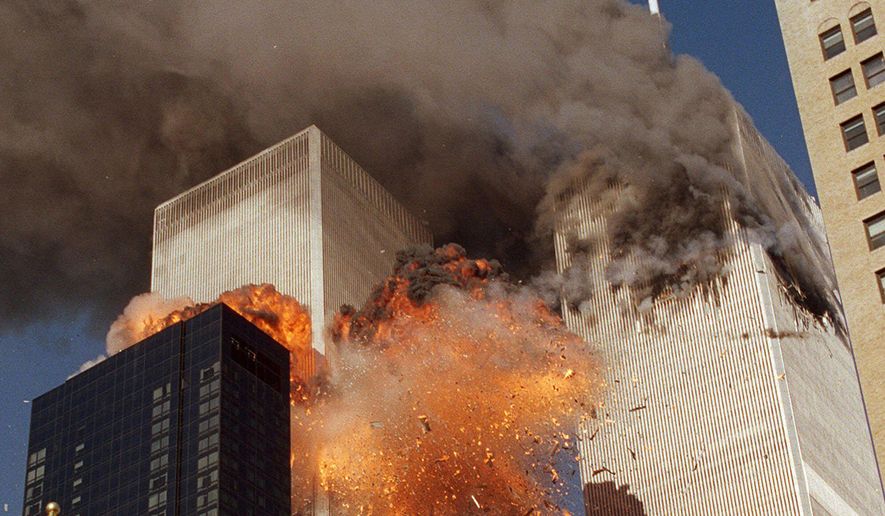More cancer cases than previously thought are expected among firefighters and rescue workers who responded in the aftermath of the Sept. 11, 2001, terrorist attacks on the World Trade Center, according to research published Thursday in the Journal of the American Medical Association.
The latest study, conducted by the World Trade Center Health Program, accompanied research on improving early detection of multiple myeloma, a blood cancer and one of the top 15 certified cancers found among those exposed to the toxic atmosphere at ground zero in lower Manhattan.
“In 2011 we, meaning our research team here, were the first to show that the cancer rates might be elevated in the WTC exposed population,” FDNY World Trade Center Health Program researcher Dr. Rachel Zeig-Owens told The Washington Times.
The WTCHP was established that year with the passage of the James Zadroga 9/11 Health and Compensation Act, named in honor of the New York City police officer who died of an aggressive respiratory disease that was later confirmed to have developed from breathing the air at ground zero in the aftermath of the terror attacks.
The program provides complete medical coverage for first responders and survivors for conditions developed as a result of being exposed to toxic elements from the terror attacks in New York City, Pennsylvania and the Pentagon.
Today, 69,612 responders and 14,308 survivors are registered with the program.
As of December, there are 6,866 responders and 1,433 survivors who are diagnosed with cancer. At least 304 responders and 30 survivors have died from cancer, according to WTCHP statistics.
The latest research by Dr. Zeig-Owens and colleagues estimates that new cancer diagnosis will increase at a higher rate than previously thought, with 2,960 new cancer cases between 2012 and 2031. Medical costs are expected be over $235 million for first-year treatment.
Previous estimates had 246 less cases.
“We project that the FDNY-WTCHP cohort will experience a greater cancer burden than would be expected from a demographically similar population,” the authors wrote. “This underscores the importance of cancer prevention efforts and routine screening in WTC-exposed rescue and recovery workers.”
The three cancers expected to increase among this population include prostate, thyroid and melanoma cancers and few lung, colorectal and kidney cancers, the study read.
“What it really does is show the continued need for cancer screening and that the risk may be elevated for years to come due to these exposures,” Dr. Zeig-Owens said. “What also is helpful for the WTC health program is to know that it needs to plan and anticipate for the elevated costs of treatment as the years go on.”
The program is working on multiple studies examining various cancers, their risk and early detection. The latest, also published Thursday in JAMA, focuses on multiple myeloma, a cancer of the blood, specifically affecting plasma cells, integral to the functioning of the immune system.
Dr. C. Ola Landgren, chief of the myeloma service at Memorial Sloan Kettering Cancer Center, said he and others were motivated to study this same population after years of seeing several newly diagnosed patients at younger ages and with more aggressive forms of the disease than normal.
“That prompted us to reach out to the FDNY to make a collaborative study,” Dr. Landgren told The Times, “to address these observations. That’s really what prompted us from the clinical side to reach out.”
Multiple myeloma causes plasma cells in the blood to become cancerous — these cells are integral to the functioning of the immune system and proper blood flow throughout the body. As the cancerous cells multiply, they crowd out health red and white blood cells and increase the risk for infection and cause problems to the kidneys, bone and calcium levels.
About 30,770 new cases are diagnosed each year, according to the American Cancer Society, and about 12,770 deaths are expected to occur from the disease.
Screening techniques for the cancer rely on detecting the presence of a specific protein in the blood, monoclonal gammopathy of undetermined significance (MGUS) and light-chain MGUS.
This protein is known as a precursor to multiple myeloma, yet not all people who have it will go on to develop the disease. Dr. Landgren and his team, then, sought to determine if there is a critical number of MGUS that is a better determinate of future disease.
They found that among firefighters and rescue workers exposed to the World Trade Center site after the attack, MGUS and light-chain MGUS were present at nearly double the rate compared to a control population.
“The consequence of the current study is, I think it provides a pretty strong case that multiple myeloma can have an environmental epidemiology. This is an important insight,” Dr. Landgren said.
• Laura Kelly can be reached at lkelly@washingtontimes.com.




Please read our comment policy before commenting.